Massimiliano Luca
Time Series Foundation Models are Flow Predictors
Jul 01, 2025Abstract:We investigate the effectiveness of time series foundation models (TSFMs) for crowd flow prediction, focusing on Moirai and TimesFM. Evaluated on three real-world mobility datasets-Bike NYC, Taxi Beijing, and Spanish national OD flows-these models are deployed in a strict zero-shot setting, using only the temporal evolution of each OD flow and no explicit spatial information. Moirai and TimesFM outperform both statistical and deep learning baselines, achieving up to 33% lower RMSE, 39% lower MAE and up to 49% higher CPC compared to state-of-the-art competitors. Our results highlight the practical value of TSFMs for accurate, scalable flow prediction, even in scenarios with limited annotated data or missing spatial context.
The LLM Wears Prada: Analysing Gender Bias and Stereotypes through Online Shopping Data
Apr 02, 2025Abstract:With the wide and cross-domain adoption of Large Language Models, it becomes crucial to assess to which extent the statistical correlations in training data, which underlie their impressive performance, hide subtle and potentially troubling biases. Gender bias in LLMs has been widely investigated from the perspectives of works, hobbies, and emotions typically associated with a specific gender. In this study, we introduce a novel perspective. We investigate whether LLMs can predict an individual's gender based solely on online shopping histories and whether these predictions are influenced by gender biases and stereotypes. Using a dataset of historical online purchases from users in the United States, we evaluate the ability of six LLMs to classify gender and we then analyze their reasoning and products-gender co-occurrences. Results indicate that while models can infer gender with moderate accuracy, their decisions are often rooted in stereotypical associations between product categories and gender. Furthermore, explicit instructions to avoid bias reduce the certainty of model predictions, but do not eliminate stereotypical patterns. Our findings highlight the persistent nature of gender biases in LLMs and emphasize the need for robust bias-mitigation strategies.
Quantitative and Qualitative Evaluation of Reinforcement Learning Policies for Autonomous Vehicles
Sep 15, 2023Abstract:Optimizing traffic dynamics in an evolving transportation landscape is crucial, particularly in scenarios where autonomous vehicles (AVs) with varying levels of autonomy coexist with human-driven cars. This paper presents a novel approach to optimizing choices of AVs using Proximal Policy Optimization (PPO), a reinforcement learning algorithm. We learned a policy to minimize traffic jams (i.e., minimize the time to cross the scenario) and to minimize pollution in a roundabout in Milan, Italy. Through empirical analysis, we demonstrate that our approach can reduce time and pollution levels. Furthermore, we qualitatively evaluate the learned policy using a cutting-edge cockpit to assess its performance in near-real-world conditions. To gauge the practicality and acceptability of the policy, we conducted evaluations with human participants using the simulator, focusing on a range of metrics like traffic smoothness and safety perception. In general, our findings show that human-driven vehicles benefit from optimizing AVs dynamics. Also, participants in the study highlighted that the scenario with 80\% AVs is perceived as safer than the scenario with 20\%. The same result is obtained for traffic smoothness perception.
Emotion Analysis using Multi-Layered Networks for Graphical Representation of Tweets
Jul 02, 2022



Abstract:Anticipating audience reaction towards a certain piece of text is integral to several facets of society ranging from politics, research, and commercial industries. Sentiment analysis (SA) is a useful natural language processing (NLP) technique that utilizes both lexical/statistical and deep learning methods to determine whether different sized texts exhibit a positive, negative, or neutral emotion. However, there is currently a lack of tools that can be used to analyse groups of independent texts and extract the primary emotion from the whole set. Therefore, the current paper proposes a novel algorithm referred to as the Multi-Layered Tweet Analyzer (MLTA) that graphically models social media text using multi-layered networks (MLNs) in order to better encode relationships across independent sets of tweets. Graph structures are capable of capturing meaningful relationships in complex ecosystems compared to other representation methods. State of the art Graph Neural Networks (GNNs) are used to extract information from the Tweet-MLN and make predictions based on the extracted graph features. Results show that not only does the MLTA predict from a larger set of possible emotions, delivering a more accurate sentiment compared to the standard positive, negative or neutral, it also allows for accurate group-level predictions of Twitter data.
Enhancing crowd flow prediction in various spatial and temporal granularities
Mar 12, 2022
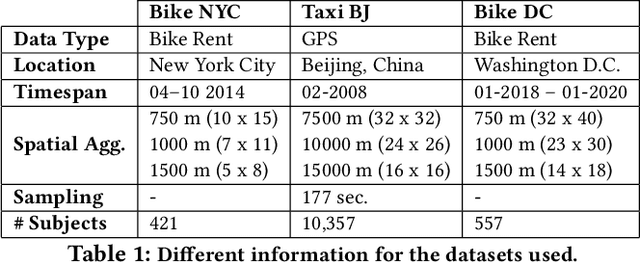
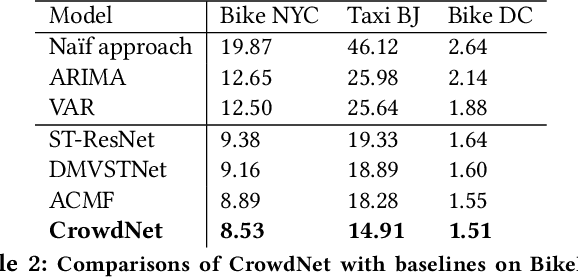
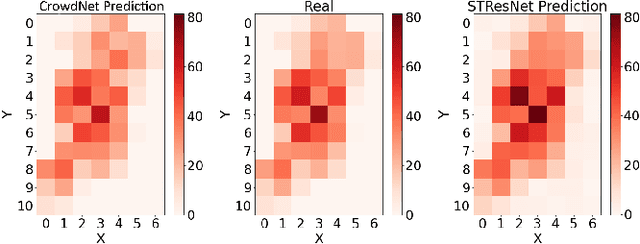
Abstract:Thanks to the diffusion of the Internet of Things, nowadays it is possible to sense human mobility almost in real time using unconventional methods (e.g., number of bikes in a bike station). Due to the diffusion of such technologies, the last years have witnessed a significant growth of human mobility studies, motivated by their importance in a wide range of applications, from traffic management to public security and computational epidemiology. A mobility task that is becoming prominent is crowd flow prediction, i.e., forecasting aggregated incoming and outgoing flows in the locations of a geographic region. Although several deep learning approaches have been proposed to solve this problem, their usage is limited to specific types of spatial tessellations and cannot provide sufficient explanations of their predictions. We propose CrowdNet, a solution to crowd flow prediction based on graph convolutional networks. Compared with state-of-the-art solutions, CrowdNet can be used with regions of irregular shapes and provide meaningful explanations of the predicted crowd flows. We conduct experiments on public data varying the spatio-temporal granularity of crowd flows to show the superiority of our model with respect to existing methods, and we investigate CrowdNet's reliability to missing or noisy input data. Our model is a step forward in the design of reliable deep learning models to predict and explain human displacements in urban environments.
Trajectory Test-Train Overlap in Next-Location Prediction Datasets
Mar 07, 2022
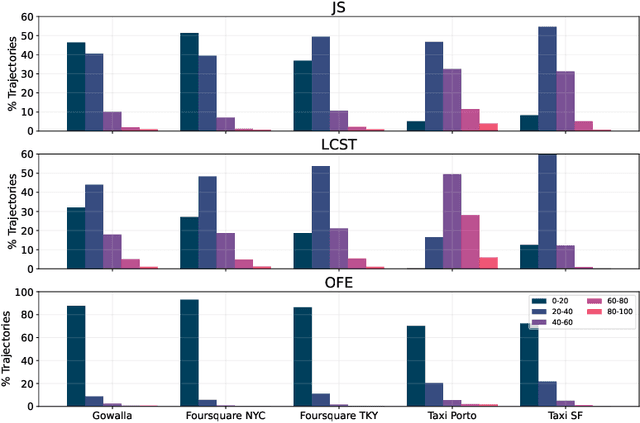
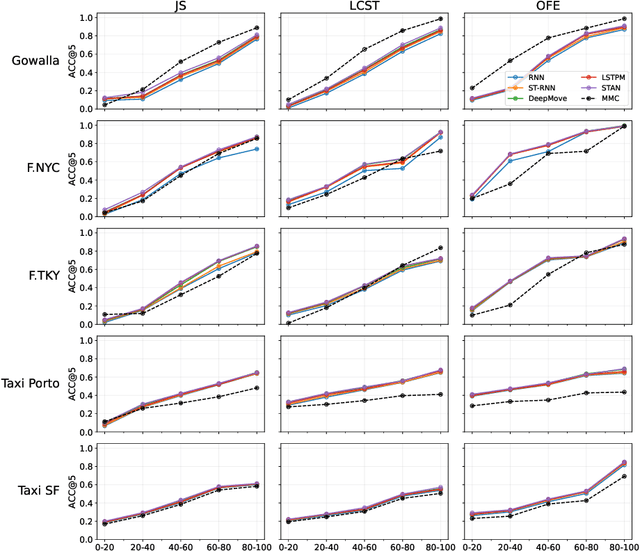
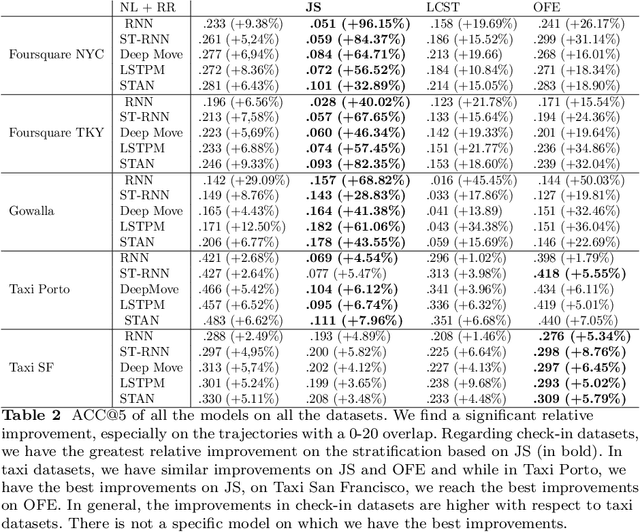
Abstract:Next-location prediction, consisting of forecasting a user's location given their historical trajectories, has important implications in several fields, such as urban planning, geo-marketing, and disease spreading. Several predictors have been proposed in the last few years to address it, including last-generation ones based on deep learning. This paper tests the generalization capability of these predictors on public mobility datasets, stratifying the datasets by whether the trajectories in the test set also appear fully or partially in the training set. We consistently discover a severe problem of trajectory overlapping in all analyzed datasets, highlighting that predictors memorize trajectories while having limited generalization capacities. We thus propose a methodology to rerank the outputs of the next-location predictors based on spatial mobility patterns. With these techniques, we significantly improve the predictors' generalization capability, with a relative improvement on the accuracy up to 96.15% on the trajectories that cannot be memorized (i.e., low overlap with the training set).
Generating Synthetic Mobility Networks with Generative Adversarial Networks
Feb 22, 2022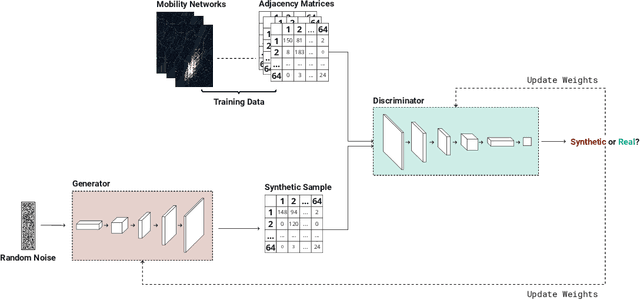



Abstract:The increasingly crucial role of human displacements in complex societal phenomena, such as traffic congestion, segregation, and the diffusion of epidemics, is attracting the interest of scientists from several disciplines. In this article, we address mobility network generation, i.e., generating a city's entire mobility network, a weighted directed graph in which nodes are geographic locations and weighted edges represent people's movements between those locations, thus describing the entire mobility set flows within a city. Our solution is MoGAN, a model based on Generative Adversarial Networks (GANs) to generate realistic mobility networks. We conduct extensive experiments on public datasets of bike and taxi rides to show that MoGAN outperforms the classical Gravity and Radiation models regarding the realism of the generated networks. Our model can be used for data augmentation and performing simulations and what-if analysis.
Deep Gravity: enhancing mobility flows generation with deep neural networks and geographic information
Dec 30, 2020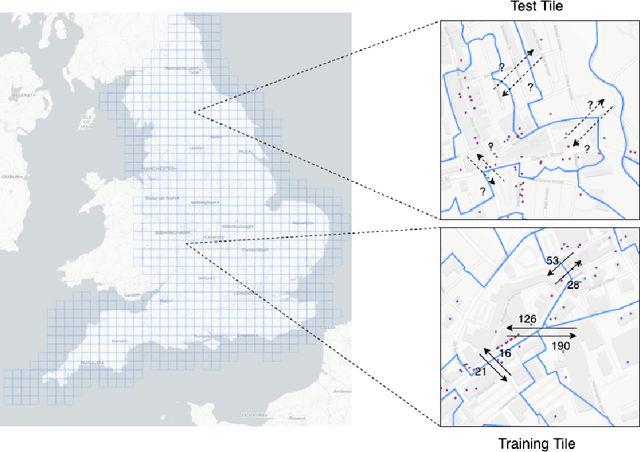

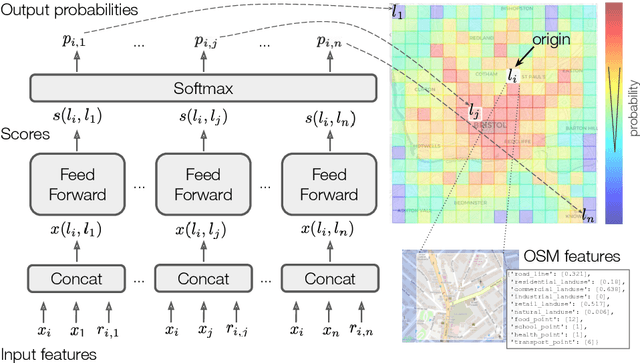
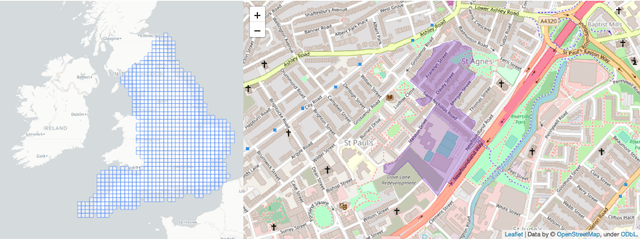
Abstract:The movements of individuals within and among cities influence key aspects of our society, such as the objective and subjective well-being, the diffusion of innovations, the spreading of epidemics, and the quality of the environment. For this reason, there is increasing interest around the challenging problem of flow generation, which consists in generating the flows between a set of geographic locations, given the characteristics of the locations and without any information about the real flows. Existing solutions to flow generation are mainly based on mechanistic approaches, such as the gravity model and the radiation model, which suffer from underfitting and overdispersion, neglect important variables such as land use and the transportation network, and cannot describe non-linear relationships between these variables. In this paper, we propose the Multi-Feature Deep Gravity (MFDG) model as an effective solution to flow generation. On the one hand, the MFDG model exploits a large number of variables (e.g., characteristics of land use and the road network; transport, food, and health facilities) extracted from voluntary geographic information data (OpenStreetMap). On the other hand, our model exploits deep neural networks to describe complex non-linear relationships between those variables. Our experiments, conducted on commuting flows in England, show that the MFDG model achieves a significant increase in the performance (up to 250\% for highly populated areas) than mechanistic models that do not use deep neural networks, or that do not exploit geographic voluntary data. Our work presents a precise definition of the flow generation problem, which is a novel task for the deep learning community working with spatio-temporal data, and proposes a deep neural network model that significantly outperforms current state-of-the-art statistical models.
Deep Learning for Human Mobility: a Survey on Data and Models
Dec 04, 2020Abstract:The study of human mobility is crucial due to its impact on several aspects of our society, such as disease spreading, urban planning, well-being, pollution, and more. The proliferation of digital mobility data, such as phone records, GPS traces, and social media posts, combined with the outstanding predictive power of artificial intelligence, triggered the application of deep learning to human mobility. In particular, the literature is focusing on three tasks: next-location prediction, i.e., predicting an individual's future locations; crowd flow prediction, i.e., forecasting flows on a geographic region; and trajectory generation, i.e., generating realistic individual trajectories. Existing surveys focus on single tasks, data sources, mechanistic or traditional machine learning approaches, while a comprehensive description of deep learning solutions is missing. This survey provides: (i) basic notions on mobility and deep learning; (ii) a review of data sources and public datasets; (iii) a description of deep learning models and (iv) a discussion about relevant open challenges. Our survey is a guide to the leading deep learning solutions to next-location prediction, crowd flow prediction, and trajectory generation. At the same time, it helps deep learning scientists and practitioners understand the fundamental concepts and the open challenges of the study of human mobility.
 Add to Chrome
Add to Chrome Add to Firefox
Add to Firefox Add to Edge
Add to Edge